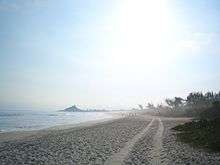Saquarema
Saquarema (Portuguese pronunciation: [sɐkwɐˈɾẽmɐ]) is a municipality located in the Brazilian state of Rio de Janeiro. Its population is 83,750 (2016) and its area is 353,566 km².[1] It is located almost 73 km east of Rio de Janeiro.[2] It was known as Brazil's surfing capital.
Saquarema | |
|---|---|
Municipality | |
| Município de Saquarema | |
 Igreja Nossa Senhora de Nazaré | |
 Flag  Seal | |
| Nickname(s): Capital Nacional do Surfing | |
 Location of Saquarema in the state of Rio de Janeiro | |
 Saquarema Location of Saquarema in Brazil | |
| Coordinates: 22°55′12″S 42°30′36″W | |
| Country | |
| Region | Southeast |
| State | |
| Government | |
| • Prefeito | Manoela Peres (PTN) |
| Area | |
| • Total | 356.566 km2 (137.671 sq mi) |
| Elevation | 2 m (7 ft) |
| Population (2010) | |
| • Total | 83,750 |
| Time zone | UTC-3 (UTC-3) |
| Website | |

Itaúna Beach, near Itaúna Inn.
A view of Saquarema's lake and church steps
During the mid-19th century, the Conservative Party and its leaders were known as "Saquarema" because of their base of support here.
The Surfing Capital
Saquarema, through its beaches, especially Itaúna Beach, is known as the Brazilian capital of surfing for its perfect waves and indescribable beauty and strength. In the 70's, Saquarema hosted the longing surfing festivals and in 2017, Saquarema became part of the world surfing circuit, with WSL.
gollark: No.
gollark: The hilarity of a joke is directly proportional to the square of its length, you know.
gollark: (note: I like Linux and this is a joke, do not potato me)
gollark: What do Linux users do to change a lightbulb?First, a user creates a bug report, only for it to be closed with "could not reproduce" as the developers got to it in the day. Eventually, some nights later, someone realizes that it is actually a problem, and decides to start work on a fix, soliciting the help of other people.Debates soon break out on the architecture of the new lightbulb - should they replace it with an incandescent bulb (since the bulb which broke was one of those), try and upgrade it to a halogen or LED bulb, which are technically superior if more complex. or go to a simpler and perhaps more reliable solution such as a fire?While an LED bulb is decided on, they eventually, after yet more debate, deem off-the-shelf bulbs unsuitable, and decide to make their own using commercially available LED modules. However, some of the group working on this are unhappy with this, and splinter off, trying to set up their own open semiconductor production operation to produce the LEDs.Despite delays introduced by feature creep, as it was decided halfway through to also add RGB capability and wireless control, the main group still manages to produce an early alpha, and tests it as a replacement for the original bulb. Unfortunately it stops working after a few days of use, and debugging of the system suggests that the problem is because of their power supply - the bulb needs complex, expensive, and somewhat easily damaged circuitry to convert the mains AC power into DC suitable for the LEDs, and they got that bit a bit wrong.So they decide to launch their own power grid and lighting fixture standard, which is, although incompatible with every other device, technically superior, and integrates high-speed networking so they can improve the control hardware. Having completely retrofitted the house the original lightbulb failed in and put all their designs and code up on GitHub, they deem the project a success, and after only a year!
gollark: Minetest is already a thing.
References
- IBGE -
- Danny Palmerlee, South America on a Shoestring (Lonely Planet, 2007: ISBN 1-74104-443-X ), p. 300.
This article is issued from Wikipedia. The text is licensed under Creative Commons - Attribution - Sharealike. Additional terms may apply for the media files.
